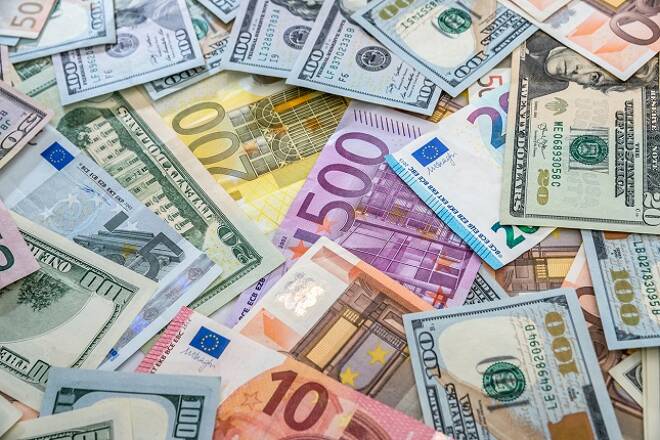Advertisement
Advertisement
EUR/USD Daily Technical Analysis for October 16, 2017
By:
The EUR/USD was unable to gain traction on Friday as rumors that the ECB will consider cutting back QE in March, was offset by softer than expected U.S.
The EUR/USD was unable to gain traction on Friday as rumors that the ECB will consider cutting back QE in March, was offset by softer than expected U.S. consumer price inflation. Wages are not growing fast enough in Europe according to Draghi while inflation in German was confirmed at 1.8%.
Technicals
The EUR/USD formed a doji day which is where the open and close are at the same level. The exchange rate attempted to move higher but ran into resistance near a downward sloping trend line that comes in near 1.1860. Support on the currency pair is seen near the 10-day moving average at 1.1774. Momentum is neutral as the MACD (moving average convergence divergence) index prints near the zero index level with a flat trajectory which reflects consolidation.
German September HICP Inflation was Confirmed and Unchanged from the Preliminary Number
German September HICP inflation was confirmed at 1.8% year over year, unchanged from the preliminary number as well as the previous month. Energy price inflation picked up again and excluding household energy and petrol the annual rate dropped back to 1.7% year over year from 1.8% year over year. Still, the German inflation rate, like the Spanish is pretty much in line with price stability now and with the labor market looking tight and wage growth above the Eurozone average while house prices continue to rise, the ECB’s monetary policy is starting to look increasingly out of synch with the German economy.
The ECB is considering Cutting Back QE
The ECB is considering cutting back QE by EUR 30 billion with 9 months extension, which would bring us to the end of September 2018. That would be a considerably longer extension than expected, and according to a report citing unnamed sources, the ECB would still maintain the option of a further extension. So, an end to QE won’t come before the start of October next year at the very earliest and Draghi stressed that the forward guidance that rates will stay low until “well past” the end of QE, that pretty much rules out a rate hike before 2019.
ECB doesn’t see sufficient progress on wages.
Draghi said the central bank is “looking very closely at the labor market and wage bargaining”, adding that while it seems some progress, but not enough. As we highlighted in our report last week, since the crisis, official unemployment measure seem to be understating the degree of slack in the labor market and alternative measures of underemployment show a much higher degree of spare capacity, which to some degree explains the fact that average wage growth remains modest.
St. Louis Fed dove Bullard said the Fed should defend the inflation target or risk losing market credibility, in some rather feisty impromptu remarks earlier. He warned that it was a “denial of reality” to think inflation and rates would soon return to the norms of the ’90’s and 2000’s. And raising rates risks a “policy mistake” that could push inflation lower, or in the extreme, make recession more likely. Bullard noted the possibility that the spread of technology is depressing prices globally in ways the Fed doesn’t understand.
U.S. Retail Sales Where Slightly Stronger than Expected
U.S. retail sales climbed 1.6% in September, with sales ex-autos up 1.0%, both a little stronger than forecast. But, the 0.2% decline in August headline sales was nudged up to -0.1%, and the ex-auto gain was revised up to 0.5% from 0.2% previously. Sales excluding autos, gas, and building materials rose 0.4% following August’s unchanged reading which was revised up from -0.1%. Auto sales surged 3.6% last month after the prior 2.1% decline which was revised from -1.6%. Gas station sales jumped 5.8%. Building materials sales increased 2.1%. Food sales were 0.8%. Clothing rose 0.4%. General merchandise edged up 0.3%. Non-store retailers increased 0.5%. On the other hand, electronics sales fell 1.1%. Furniture dipped 0.4%. Health and personal care sales fell 0.4%. And miscellaneous sales slid 0.6%.
U.S. CPI rose 0.5%, with the core rate up 0.1% in September
U.S. CPI rose 0.5%, with the core rate up 0.1% in September. Not as hot as feared after the PPI jump Thursday. August gains of 0.4% overall and 0.2% on the core were not revised. Compared to last year, the headline number rose to a 2.2% year over year pace, versus 1.9% year over year previously, while the ex-food and energy component was steady at 1.7% year over year. The components showed energy led the uptick, climbing 6.1% after the prior 2.8% gain. Transportation increased 2.8%, while commodities were up 1.1%. Aside from those, gains were more modest. Food prices increased 0.1%. Housing costs edged up 0.2%, as did the owner equivalent rent measure. Medical care and apparel prices each fell 0.1%.
About the Author
David Beckerauthor
David Becker focuses his attention on various consulting and portfolio management activities at Fortuity LLC, where he currently provides oversight for a multimillion-dollar portfolio consisting of commodities, debt, equities, real estate, and more.
Did you find this article useful?
Latest news and analysis
Advertisement
